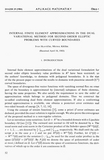Article
Full entry |
 PDF
(2.0 MB)
Feedback
PDF
(2.0 MB)
Feedback
 PDF
(2.0 MB)
Feedback
PDF
(2.0 MB)
Feedback
Keywords:
dual variational methods; stream function; finite element; piecewise smooth boundary; dual problem; optimal rate of convergence
dual variational methods; stream function; finite element; piecewise smooth boundary; dual problem; optimal rate of convergence
Summary:
Using the stream function, some finite element subspaces of divergence-free vector functions, the normal components of which vanish on a part of the piecewise smooth boundary, are constructed. Applying these subspaces, an internal approximation of the dual problem for second order elliptic equations is defined.
A convergence of this method is proved without any assumption of a regularity of the solution. For sufficiently smooth solutions an optimal rate of convergence is proved. The internal approximation can be obtained by solving a system of linear algebraic equations with a positive definite matrix.
References:
[1] P. G. Ciarlet: The finite element method for elliptic problems. North-Holland, Amsterdam, New York, Oxford, 1978. MR 0520174 | Zbl 0383.65058
[2] P. G. Ciarlet P. A. Raviart: Interpolation theory over curved elements, with applications to finite element methods. Comput. Methods Appl. Mech. Engrg. 1 (1972), 217-249. DOI 10.1016/0045-7825(72)90006-0 | MR 0375801
[3] P. Doktor: On the density of smooth functions in certain subspaces of Sobolev spaces. Comment. Math. Univ. Carolin. 14, 4 (1973), 609-622. MR 0336317
[4] B. M. Fraeijs de Veubeke M. Hogge: Dual analysis for heat conduction problems by finite elements. Internat. J. Numer. Methods Engrg. 5 (1972), 65-82. DOI 10.1002/nme.1620050107
[5] V. Girault P. A. Raviart: Finite element approximation of the Navier-Stokes equations. Springer-Verlg, Berlin, Heidelberg, New York, 1979. MR 0548867
[6] J. Haslinger I. Hlaváček: Contact between elastic perfectly plastic bodies. Apl. Mat. 27 (1982), 27-45. MR 0640138
[7] J. Haslinger I. Hlaváček: Convergence of a finite element method based on the dual variational formulation. Apl. Mat. 21 (1976), 43 - 65. MR 0398126
[8] I. Hlaváček: The density of solenoidal functions and the convergence of a dual finite element method. Apl. Mat. 25 (1980), 39-55. MR 0554090
[9] M. Křížek: Conforming equilibrium finite element methods for some elliptic plane problems. RAIRO Anal. Numer. 17 (1983), 35--65. DOI 10.1051/m2an/1983170100351 | MR 0695451
[10] O. A. Ladyzenskaya: The mathematical theory of viscous incompressible flow. Gordon & Breach, New York, 1969. MR 0254401
[11] J. Nečas: Les méthodes directes en théorie des équations elliptiques. Academia, Prague, 1967. MR 0227584
[12] J. Nečas I. Hlaváček: Mathematical theory of elastic and elasto-plastic bodies: an introduction. Elsevier Scientific Publishing Company, Amsterdam, Oxford, New York, 1981. MR 0600655
[13] P. Neittaanmäki J. Saranen: On finite element approximation of the gradient for solution of Poisson equation. Numer. Math. 37 (1981), 333-337. DOI 10.1007/BF01400312 | MR 0627107
[14] J. Penman J. R. Fraser: Complementary and dual energy finite element principles in magnetostatics. IEEE Trans. on Magnetics 18 (1982), 319-324. DOI 10.1109/TMAG.1982.1061883
[15] G. Strang G. J. Fix: An analysis of the finite element method. Prentice Hall, New Jersey, 1973. MR 0443377
[16] J. M. Thomas: Sur l'analyse numérique des méthodes d'éléments finis hybrides et mixtes. Thesis, Université Paris VI, 1977.
[17] M. Zlámal: Curved elements in the finite element method. Čislennyje metody mechaniki splošnoj sredy, SO AN SSSR, 4 (1973), No. 5, 25-49.
[18] M. Zlámal: Curved elements in the finite element method. SIAM J. Numer. Anal. 10 (1973), 229-240. DOI 10.1137/0710022 | MR 0395263

